In this post, we will show you Deply Cisco Jabber Using SCCM MSI Application Model. We will use the MSI application to deploy Cisco Jabber using SCCM on Windows 10/11 client machines.
Jabber unified communication software is available for Windows, macOS, and mobile devices. With Cisco Jabber, you can chat online, make voice and video calls, send voice messages, share your desktop, participate in conferences, and be present.
The presence of an installer makes it easier for you to find the right people, to see whether and how they are available, and to collaborate better.
The Jabber protocol, also known as XMPP, allows you to send chat messages. The Jabber client plug-in makes it easy for hackers, techies, and journalists to communicate with each other thanks to the ability to encrypt communications.
You can place and transfer calls with Cisco Jabber from your desktop, laptop, or mobile device just like with Microsoft Teams. It is even possible to record or invite others to the call, to include a visual voicemail, and to incorporate video at any time.
- Best Option to Deploy MS Teams MSI Using SCCM | ConfigMgr
- Slack Deployment Using SCCM MSI Application Guide
What is an MSI file?
Windows packages that contain installation information, including files to be installed and installation locations, are called MSI files. The EXE and MSI files both install and launch Windows programs.
The EXE file may not always contain an installer and may launch its program when double-clicked. An MSI file, however, always includes an installer.
Cisco Jabber Install Uninstall Commands
Let’s start with the Deployment of Cisco Jabber using SCCM. As told earlier, we are using the MSI file for Cisco Jabber Deployment. You will see why the availability of MSI files for any application brings sparkles in the eyes of the SCCM Admin.
Now as we get the MSI, we don’t need to work on prerequisites as we used to tell you in the previous posts in which we used EXE files. Here’s how you can Download Cisco Jabber MSI Installers for Windows.
- We have to download the logo of Cisco Jabber, as we have already extracted the MSI file.
The following table gives you all the details required for the Cisco Jabber Deployment tool using SCCM. This includes the command line for Cisco Jabber silent install, Uninstall, and Product Code.
| Name | Install Command Line | Uninstall Command Line | Detection Method |
|---|---|---|---|
| Cisco Jabber Deployment Tool – Windows Installer (*.msi file) | Install -> msiexec /i “CiscoJabberSetup.msi” /q | Uninstall -> msiexec /x {E6279864-E7A0-460B-A977-C5747139A5EE} /q | Windows Installer – {E6279864-E7A0-460B-A977-C5747139A5EE} |
- Deployment of Amazon WorkSpaces using SCCM | MSI Application Guide
- Bitwarden Deployment Using SCCM | Deploy EXE File
Create Cisco Jabber Application Using SCCM Console
This MSI application deployment guide will use the SCCM admin console to create an application. To start with the Application creation part, copy the downloaded setup to the package source location of the SCCM Server.
- Navigate to SCCM Console\Software Library\Overview\Application Management\ Applications.
- Right-click on Applications and select Create Application.

For all MSI application deployments, always Select the Automatically detect Information about the application from installation files and choose Windows Installer (.msi files) in the Type category. Also, enter the UNC Path for the application in Location and click Next, as shown below.

Now you will see the real Magic!! As soon you click on next, you will see that all the information has been imported from the MSI file, as shown below, and click Next.

Also, in the General Information Tab shown below, you will see it imports the install behavior/command from the installer itself.
- Silent Command Line for Cisco Jabber = msiexec /i “CiscoJabberSetup.msi” /q
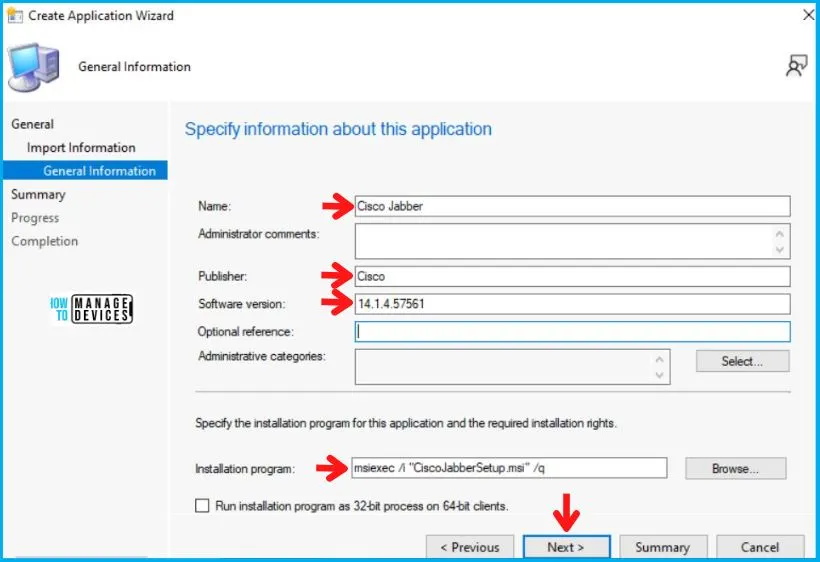
After this, click Next on the Summary Tab and end this Create Application Wizard by clicking on Close in Completion Tab.

After the creation of the Application, it will appear in the Application Node. Now to Add an Icon to Cisco Jabber, right-click on Cisco Jabber and click on Properties.
After this, choose Software Center Tab. And click on Browse in Icon, select the icon, and click on Apply and OK, as shown in the image below.
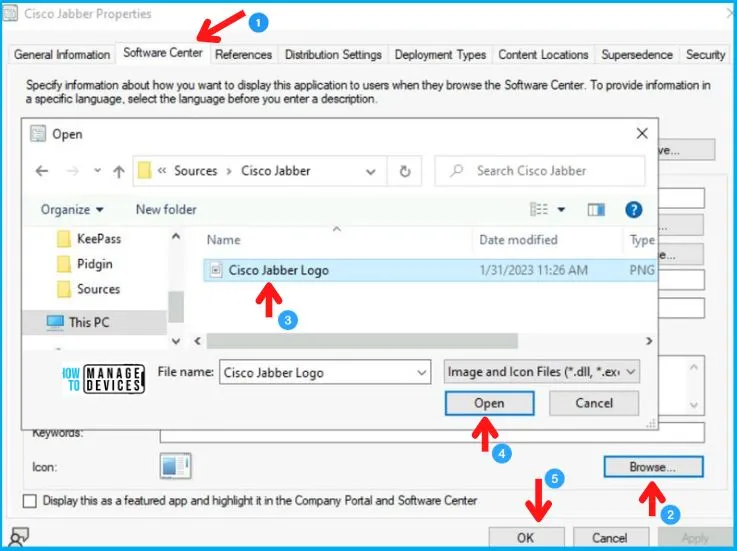
Distribute Cisco Jabber Application
After the creation of the Application, it will appear in the Application Node. To begin with, the distribution right-clicks on the Cisco Jabber Application and clicks on Distribute Content, as shown in the picture below.
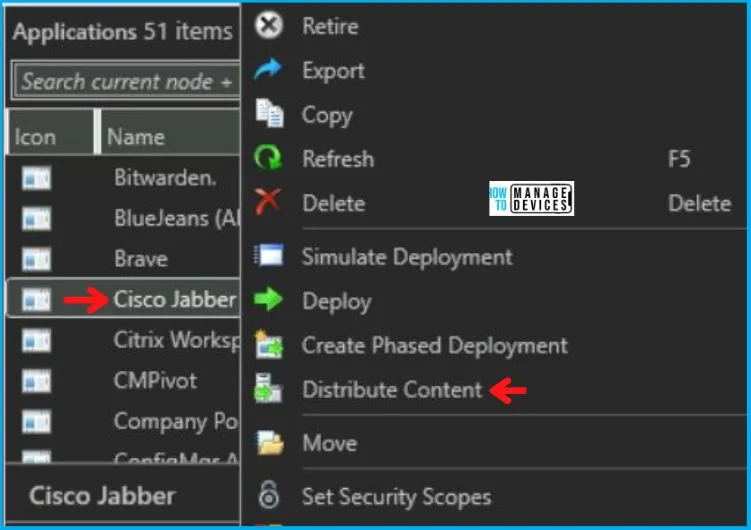
Now the Distribute Content Wizard will open, and click Next in the General Tab. Then select the Application Name in the Content Tab and Click on Next. After this, in the Content Destination Tab, Click on Add and select the Distribution Point option.

Then Add Distribution Point page will pop up, choose the Distribution Point on which you want to distribute the Application and click on OK, and then on Next.

After this, Click Next on Summary Tab and complete this Distribution process by clicking Close on Completion Tab.

Cisco Jabber Deployment Using SCCM
So as of now, we have accomplished two tasks i.e., Application Creation and Application Distribution to the DP. Now all that is left is the Deployment of the Cisco Jabber on the All Windows 10 Device Collection.
As you can see, your Application is displaying in Application Node, Right-click on Cisco Jabber and select Deploy.
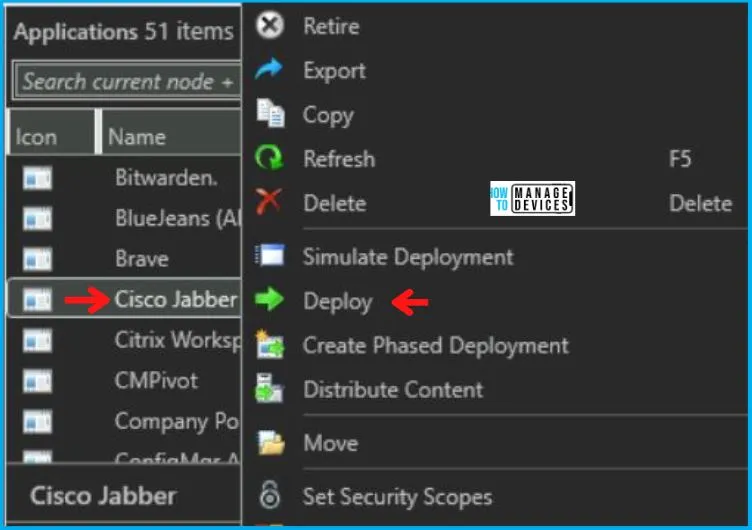
After this, Deploy Software Wizard opens, and in the General Tab, enter the Name of the Application and click on Browse to select the Collection.
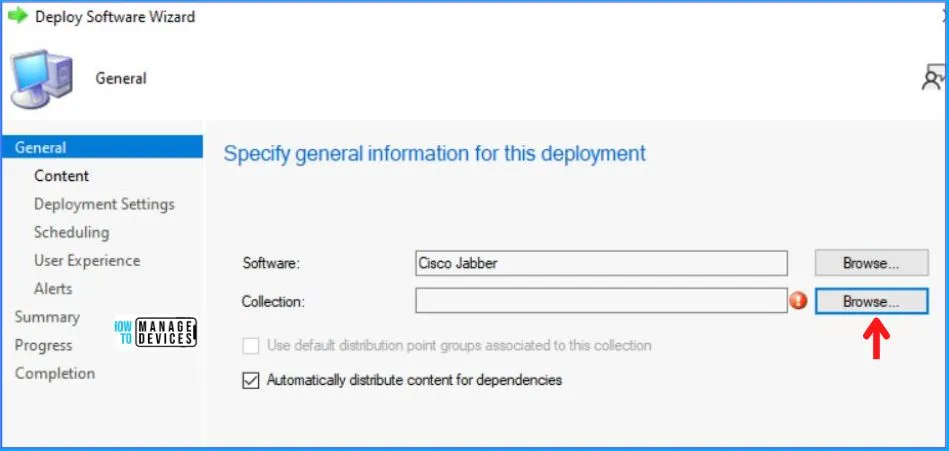
Now the Select Collection page will pop up; choose Device Collection from the drop-down menu, and then
- Select your targeted Device Collection and click on OK, and then Next.
- Here I choose All Windows 10 Devices.

Now in the Deployment Settings Tab, select:
- Install in the Action box
- And choose Available in the Purpose category.

In the Scheduling Tab, enter the time details if you want it to be available at a specific time; otherwise, leave it as it is and click Next. After this, in the User Experience Tab,
Select Display in Software Center and shows all notification options in the User notifications, and click on Next as shown below.

In the Alerts and Summary Tab, click on Next, and to end the process, click on Close in the Completion Tab.

Time to log in to Windows Machine
In this section, we will check the end-user experience for Cisco Jabber Application Deployment and Installation. The Cisco Jabber Application is Created, Distributed, and Deployed.
To test the deployment quickly on a lab device, you can manually initiate the machine policy either from Windows 10 device or from the console, as shown below in the image.

Now, if you check the Software Center of Win 10 device from the Windows 10 Device (or All Windows 11 Device) Collection, you will see the Application in Available Mode, and the user can install it as per the requirement.

As you can see in the below screenshot, the Cisco Jabber Application is installed successfully on Windows 10/11 devices. This proves that the above MSI installer works fine for Cisco Jabber Application Installation using SCCM.

So the above picture depicts that we have finally created, Distributed, Deployed, and Installed the Cisco Jabber Application shown in the Software Center as shown in the above image.
Author
Abhinav Rana is working as an SCCM Admin. He loves to help the community by sharing his knowledge. He is a BTech graduate in Information Technology.
